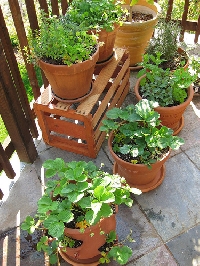
Design and build a container garden with these quick and easy tips.
If you’re wondering how to build a container garden, you’re not alone. It’s a popular hobby and a great way to save space.
Generally, any plant that can be grown in the soil can be grown in containers, but every plant has different requirements and maturity rates. For example, most tropical outdoor container plants need warm temperatures year-round and they usually bloom in summer. Tulips, on the other hand, are a welcome sight in spring. One of the benefits of containers is that it’s easy to move plants around. Showcase tulips in spring, and then move them out of view while summer-blooming plants take center stage.
Choosing a Container
You may purchase plastic, clay, terracotta, wood, concrete, or ceramic pots and hanging baskets but it’s not required. Choose garden planters and containers based upon your climate and circumstances. For example, ceramic pots may crack in cold climates. If you choose wood containers, remember that redwood and cedar are rot-resistant, and you should avoid chemically-treated wood for vegetables. However, wooden, plastic, composite or concrete planters may be used year-round.
Many people transform ordinary items, such as wooden barrels or rusted-out wheelbarrows, into planters by making a 1/2-inch drainage hole in the bottom with a drill. Plants in containers which are too small become root-bound; choose containers to match the size of the mature plant.
~
How to Build a Container Garden
- Use a high quality, lightweight planting soil. Regular soil is too heavy.
- Add a commercial organic fertilizer according to label directions, or make your own organic fertilizer, such as composted manure.
- Put landscape fabric, newspaper or rocks over the drainage hole to reduce soil loss. Line hanging baskets with sphagnum moss.
- Purchase transplants from a nursery or grow your own from seeds. Lightly loosen the roots around the root ball of transplants. Place the plant upright in the container and pull dirt up around the roots. A layer of mulch on top reduces water loss.
- Containers dry out faster than plants in the ground. Saturate the plant and roots with an inch of water per week – more during dry spells.
- Repeat applications of organic fertilizer bi-weekly, or follow label directions. Kelp and fish emulsion are excellent boosters.
- Raise containers two inches off the floor or ground for good drainage.
Choose a Location
Place containers in any sunny spot, such as a patio, balcony, window box or flat roof. The area should receive five to six hours of sunlight daily. Some plants prefer shade but others require full sun. Select the site based upon the plant’s needs.
Container Vegetable Gardening
Flowers are not the only plants that thrive in containers. You may grow vegetables too. Vegetables that do well in container gardens include:
- Bush beans
- Cucumbers*
- Eggplant
- Green onions
- Lettuce
- Parsley
- Peppers
- Pole beans*
- Spinach
- Squash
- Tomato*
- Turnip
*Needs a support system.
Design a Themed Garden
Now that you know how to build a container garden, you may want to develop themes and color schemes. For example, you might create a “pizza garden,” “aroma garden,” or “tea garden.” Themed containers make great gifts. Arrange plants in pleasing mixtures of colors, contrasting textures and heights. Trailing flowers look great spilling over the sides of containers, while tall plants look best in the middle or at the back. Accessorize with an outdoor garden sculpture or statue to create a unique container garden. Experiment, add your signature style and enjoy your garden!
References:
Vegetable Gardening in Containers
Container Gardening
